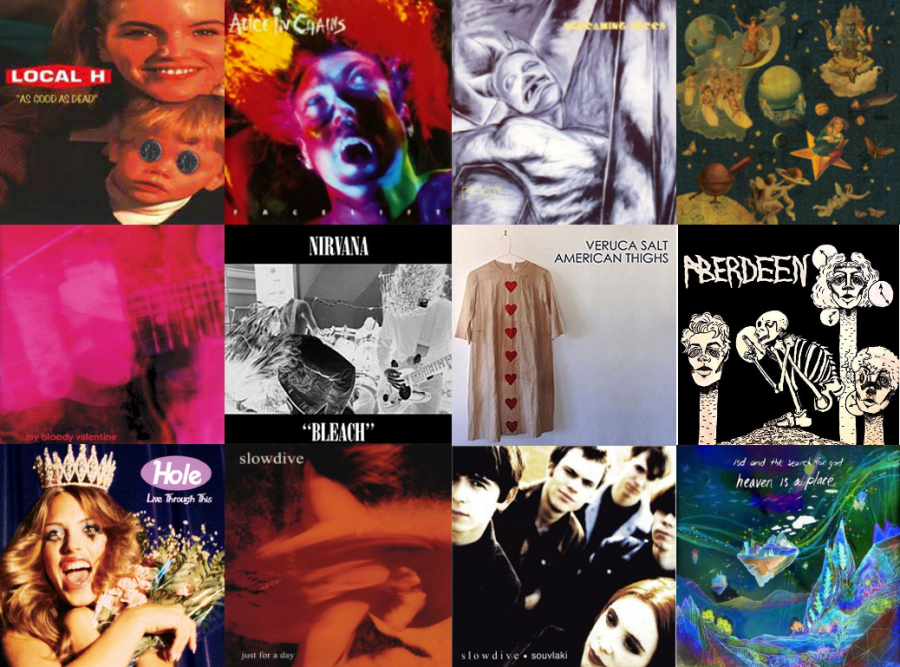A Spotlight on Alternative Music
Music genres that originated in the 20th century are finding their way back into pop culture once again. Each genre has a unique story behind the sound.
Graphic courtesy of Celeste Cariker
Many prominent albums from different points in time define the sound of entire genres and take them to new levels.
February 14, 2023
Shoegaze
Shoegaze first popped up in the United Kingdom in the 1980s and eventually spread to the United States in the early 1990s. It originated from the 1980s neo-psychedelic new wave movement. Inspiration is taken from The Cure, as well as the Cocteau Twins who began defining the sound in the 1980s. Popularized by the Creation Records label, the term “shoegaze” was coined from performers looking down at their guitar pedals.
Shoegaze music consists of heavy effects, bent guitar distortion, feedback, and waves of heavy, unified volume. Long riffs are accompanied by blending vocals. Lyrics themselves are deep yet modest and mysterious, evoking thought and allowing themselves to be relatable and decipherable. Motionless, detached live performances focus on delivering the sound. Drums oftentimes drag the beat, reinforcing the droning effect of the music.
Popular examples include Loveless by My Bloody Valentine, released in 1991, Just for a Day by Slowdive, released in 1991, Ringo Deathstarr’s self titled album, released in 2020, Tired of Tomorrow by Nothing, released in 2016, and Sway by Whirr, released in 2012.
Shoegaze popularity was ultimately overshadowed by the grunge and gothic rock movements of the mid-90s that catered to the more “in your face” emotional lyrics and rough instrumentals. Lyrical depth and rawness was valued over the melodicism and atmosphere of shoegaze. The end of first-wave shoegaze is pinpointed around the mid-1990s. However, a silent resurgence began in 2007 and with the release of LSD and the Search for God’s EP, and the reunion of My Bloody Valentine who originally began splitting in 1995. Modern shoegaze is led by bands such as Nothing, Whirr, and Glare who established themselves in the 2010s.
Though never popular in the mainstream, shoegaze made a lasting impact in the world of music. Ambient elements from shoegaze influenced styles of music that centered around creating an atmosphere, such as dream pop and black metal. Additionally, shoegaze showcases many techniques and sounds that are seen in late 1990’s alternative rock. Popular bands such as The Smashing Pumpkins have cited shoegaze influences.
Grunge
A fusion of punk rock and heavy metal, as well as free-form noise, grunge originated in the mid-1980s in Seattle, Washington. The Sub Pop label originally popularized the genre, signing many bands that are now known as staples of grunge. Post-hardcore’s style of looseness and aggression is a significant influence. Nirvana’s Krist Novoselic has credited Black Flag’s hardcore style in the mid-80s as well as Sonic Youth’s noise-rock as influential to grunge.
Grunge consists of brutally honest lyrics that showcase raw emotion and angst. Themes center around addiction, isolation, abuse, and emotional turmoil. The term “grunge” originated from the idea of a sludgy and dirty sound, exemplified by the genre’s gritty vocals, distorted amplification, energetic and banging drums, and loose guitar riffs.
Popular examples include Facelift by Alice in Chains, released in 1990, Dust by Screaming Trees, released in 1996, As Good As Dead by Local H, released in 1996, American Thighs by Veruca Salt, released in 1994, and Bleach by Nirvana, released in 1989.
The post-grunge movement took the sloppiness and aggression that categorized grunge and tempered it for a more mainstream, radio-appropriate sound. Great examples of this are Bush and Weezer. Britpop developed in the United Kingdom as a counter-movement to the dark and aggressive themes of grunge. Britpop sound consists of youthful twanging guitars and brighter, catchier singing. Second-wave “post-grunge” consists of Foo Fighters and Nickelback, which have been criticized for their commercial sound as well as their lyrics which no longer consist of the same angst about troubling topics, and now tend to center around romance and community. Modern grunge is led by bands that established themselves in the late 2010s such as Narrow Head and Aberdeen is Dead, as well as classic grunge bands Local H and The Smashing Pumpkins who are still active in recent years.
Due to the grunge movement expanding alongside the digital revolution, grunge was an extremely generation-defining sound that influenced both the underground and commercial scenes of music, as well as trends in the fashion world due to the influence of icons such as Courtney Love. Grunge brought honesty and rawness into the world of music, giving an outlet to many people working through difficult emotions that has lasted into present day and has influenced many bands that belong to the “emo” sub-genre.



